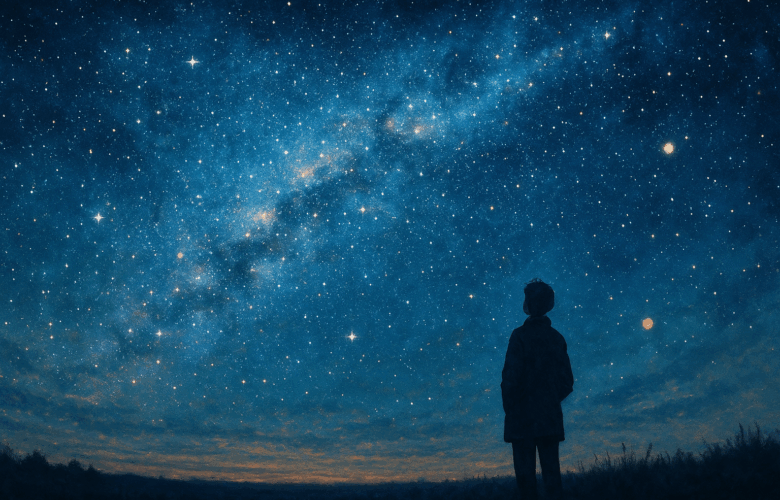A reflection on astronomy and the night sky as spiritual practice
There is a kind of prayer you don’t learn in any church.
It happens when you look up.
Not just a glance at the sky on your way to the car, but a long gaze—one that stretches the limits of your eyes, and then your mind, and then your sense of self. The kind of looking that stops time. That pulls silence over your shoulders like a cloak. That makes you forget, for a while, the pettiness of rush hours and arguments and grocery lists.
It’s the kind of looking that brings you face to face with the universe. And it feels like the universe is looking back.
Stardust and the Sacred
We are, quite literally, made of stars. That’s not a metaphor—it’s physics. The iron in your blood, the calcium in your bones, the oxygen in your lungs—born in the death throes of ancient stars, flung across galaxies, and gathered together by gravity and time to become… you.
Astronomy reminds us that we are not separate from the cosmos—we are the cosmos, awake and observing itself.
That’s not just science. That’s sacred.
Not sacred because someone declared it so with ritual or robes or holy books—but because it reaches into us with wonder. It makes something in us quiet and reverent and alive. That’s all the sacrament we need.
The Original Temple
Before temples were carved from stone, before doctrines were carved into scrolls, people looked up. The sky was the first cathedral. The stars, its eternal stained-glass windows. The planets, its wandering priests. The moon, its shifting lamp.
No gatekeeper stood between us and the divine when it was scattered across the night sky.
Our ancestors gathered around fires and told stories about those lights above. They didn’t know yet what stars were, but they knew what they meant: mystery. Beauty. Meaning. Danger. Hope.
They gave them names. They placed gods and monsters among them. They traced the journeys of heroes and the signs of the seasons in their movement. And in doing so, they passed down a truth deeper than astronomy:
That to wonder is to worship.
Awe Without Answers
Modern astronomy has replaced mythology with measurement. We know now that stars don’t sing like angels. They explode. Collapse. Reignite. They orbit black holes and collide in cosmic ballet. We’ve seen galaxies through telescopes that are older than Earth itself.
And yet… the awe hasn’t gone away.
If anything, it’s grown. Because now we understand just enough to glimpse the scale of what we don’t understand. Every answer gives birth to a dozen new questions. And that endless unraveling of mystery is its own kind of miracle.
When we look up, we no longer need to imagine gods beyond the stars. The stars themselves are enough.
Their silence speaks louder than scripture.
Their beauty needs no doctrine.
A Spiritual Practice of Looking Up
We talk a lot about mindfulness these days. But how often do we practice cosmic mindfulness?
You don’t need incense or chanting or a belief system to feel the sacredness of the sky. You just need to go outside. Leave your phone. Let your eyes adjust. Let your ego dissolve.
Stargazing can be meditation. It can be prayer. It can be the purest form of spiritual practice:
- Not asking for anything.
- Not seeking to explain.
- Just being present with the infinite.
This is a kind of religion not bound by rules but by relationship—your relationship with the vastness above you, and the smallness within you. And the strange sense that those two things are not opposed, but beautifully, impossibly intertwined.
What If the Stars Were Our Scripture?
What if, instead of quoting verses, we told stories of the first time we saw Saturn’s rings through a telescope?
What if we taught our children the names of constellations the way others teach commandments?
What if we measured our lives not by status or sin, but by how often we let ourselves be stunned by beauty?
What if we looked up more often, and let that looking change us?
Sacred Play in the Universe
The universe, it seems, has a sense of humor. It hid black holes in plain sight. It made space smell faintly like raspberries (thanks to ethyl formate in the dust clouds of Sagittarius B2). It scattered a trillion galaxies like glitter across a canvas so wide our minds can’t hold it.
We live in a cosmic playground.
But somewhere along the line, religion told us to be serious. To fear. To obey.
The stars remind us to wonder. To play. To be curious. To let awe make us humble, not small.
This is the invitation of sacred play:
To find the holy in the honest.
To let facts deepen our reverence.
To celebrate the dance of atoms and the breath of galaxies.
Come Outside
Tonight, go outside.
Even if the light pollution drowns out the stars, look anyway. Even if clouds hide them, look anyway. They are there. Just beyond what you can see.
And you—you are part of them.
Not because a priest told you so. Not because a book claims it. But because the atoms in your skin once burned in a star, and the fire in your chest is the echo of that light.
Let the stars be your religion, if only for tonight.
No dogma. No division.
Just awe.
Just looking up.


